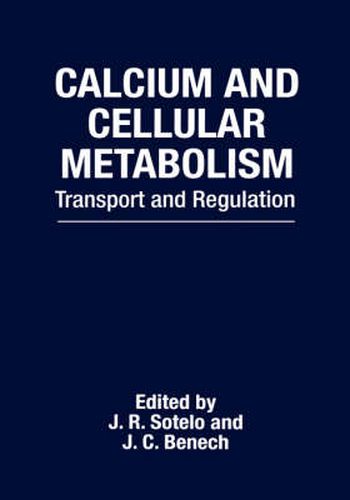Readings Newsletter
Become a Readings Member to make your shopping experience even easier.
Sign in or sign up for free!
You’re not far away from qualifying for FREE standard shipping within Australia
You’ve qualified for FREE standard shipping within Australia
The cart is loading…






This title is printed to order. This book may have been self-published. If so, we cannot guarantee the quality of the content. In the main most books will have gone through the editing process however some may not. We therefore suggest that you be aware of this before ordering this book. If in doubt check either the author or publisher’s details as we are unable to accept any returns unless they are faulty. Please contact us if you have any questions.
When we began to organize the workshop Calcium and Cellular Metabolism: Transport and Regulation the goal we had in mind was to put together the knowledge of 2 several specialists on Ca + homeostasis, with various examples of cellular metabolisms 2 2 (such as protein synthesis), regulated by Ca + ions. Regarding the homeostasis of Ca + ions, we invited Ernesto Carafoli to write the first chapter as a general state-of-the-art introductory review. On the other hand, the other chapters are the contribution of different specialists on membrane calcium transport mechanisms, aiming to reunite at least in part the wide field of calcium homeostasis. We roughly try to group chapters that share similar subjects. The first group of chapters (Chapters 2 to 6), are mainly related to calcium channels. Thus, Chapter 2 by Rodolfo Llimis et a!. describes a new concept related to the dimen sions of the calcium action domain at the inner mouth of calcium channels in the squid gi ant synapse and its relationship to neurotransmitter release. Chapter 3 by Martin Morad et a!. informs us about new ways of identifying and measuring, by confocal microscopy, in dividual sites where calcium release occurs in ventricular myocytes. In the same group Osvaldo Uchitel and Eleonora Katz classify and evaluate the variety of calcium channels at the neuromuscular junction, in Chapter 4. Chapter 5 by Gustavo Brum et a!.
$9.00 standard shipping within Australia
FREE standard shipping within Australia for orders over $100.00
Express & International shipping calculated at checkout
This title is printed to order. This book may have been self-published. If so, we cannot guarantee the quality of the content. In the main most books will have gone through the editing process however some may not. We therefore suggest that you be aware of this before ordering this book. If in doubt check either the author or publisher’s details as we are unable to accept any returns unless they are faulty. Please contact us if you have any questions.
When we began to organize the workshop Calcium and Cellular Metabolism: Transport and Regulation the goal we had in mind was to put together the knowledge of 2 several specialists on Ca + homeostasis, with various examples of cellular metabolisms 2 2 (such as protein synthesis), regulated by Ca + ions. Regarding the homeostasis of Ca + ions, we invited Ernesto Carafoli to write the first chapter as a general state-of-the-art introductory review. On the other hand, the other chapters are the contribution of different specialists on membrane calcium transport mechanisms, aiming to reunite at least in part the wide field of calcium homeostasis. We roughly try to group chapters that share similar subjects. The first group of chapters (Chapters 2 to 6), are mainly related to calcium channels. Thus, Chapter 2 by Rodolfo Llimis et a!. describes a new concept related to the dimen sions of the calcium action domain at the inner mouth of calcium channels in the squid gi ant synapse and its relationship to neurotransmitter release. Chapter 3 by Martin Morad et a!. informs us about new ways of identifying and measuring, by confocal microscopy, in dividual sites where calcium release occurs in ventricular myocytes. In the same group Osvaldo Uchitel and Eleonora Katz classify and evaluate the variety of calcium channels at the neuromuscular junction, in Chapter 4. Chapter 5 by Gustavo Brum et a!.